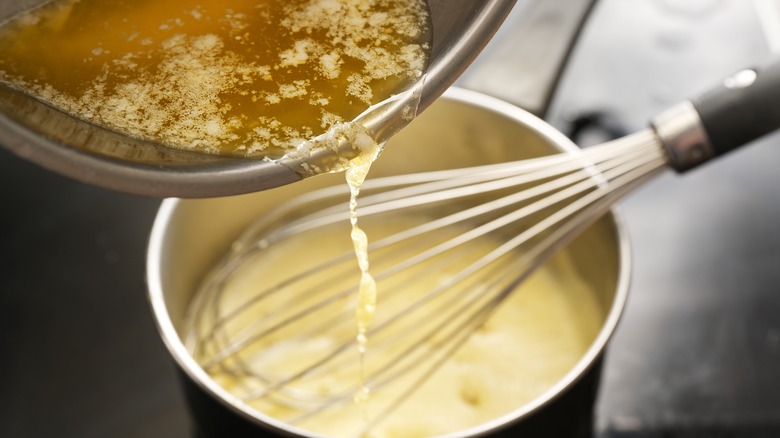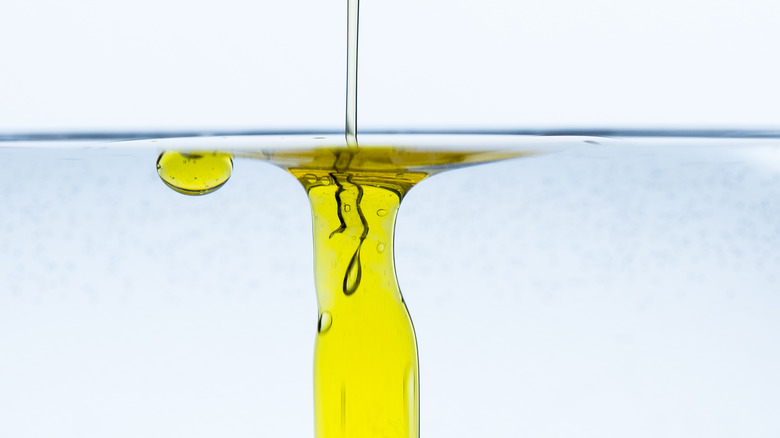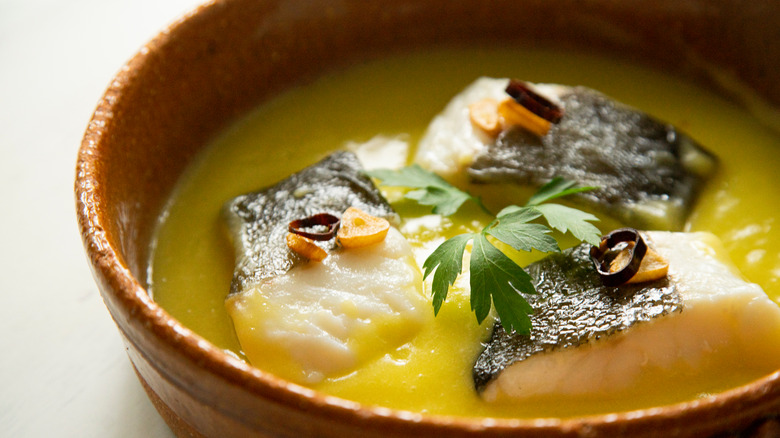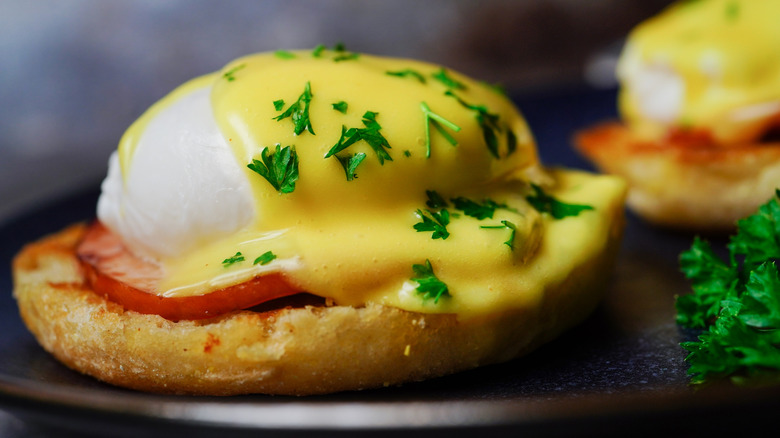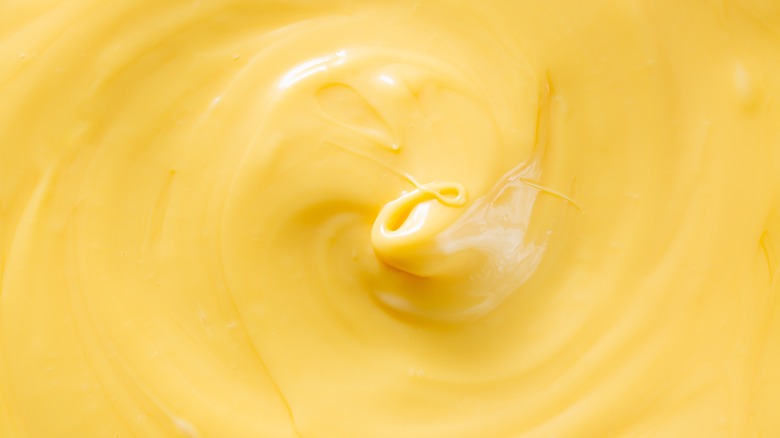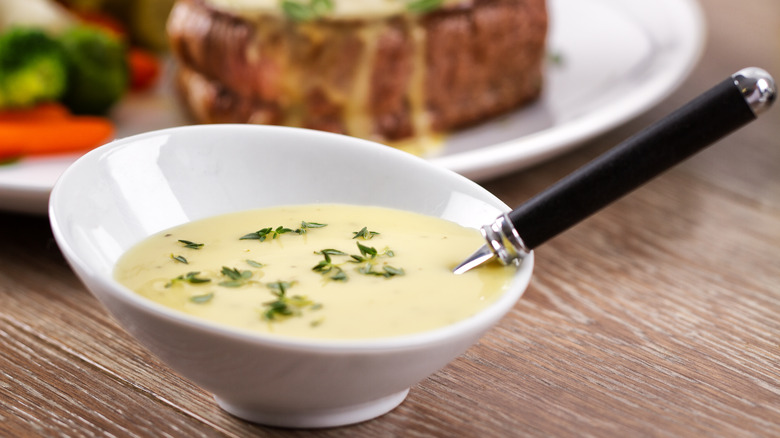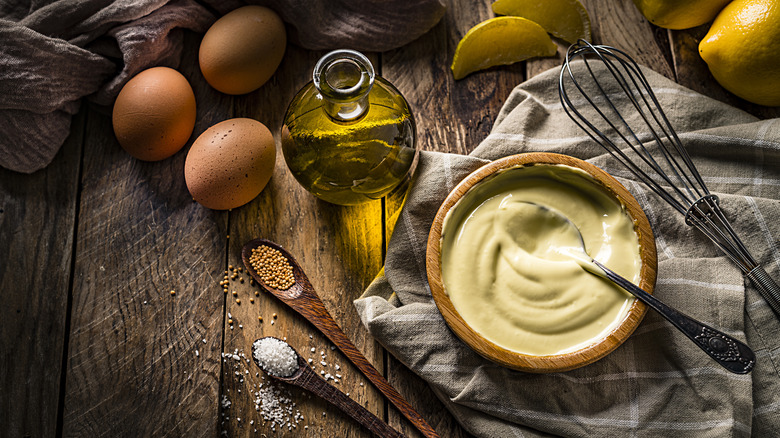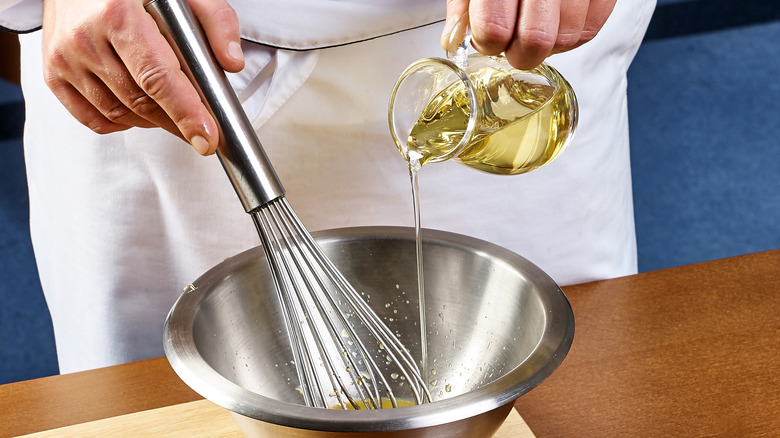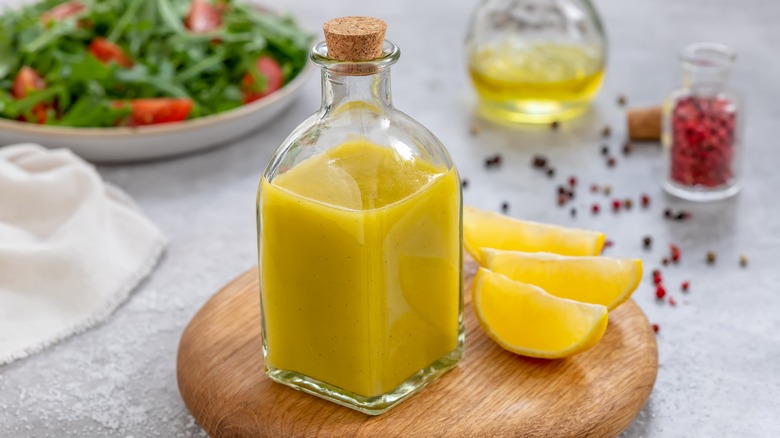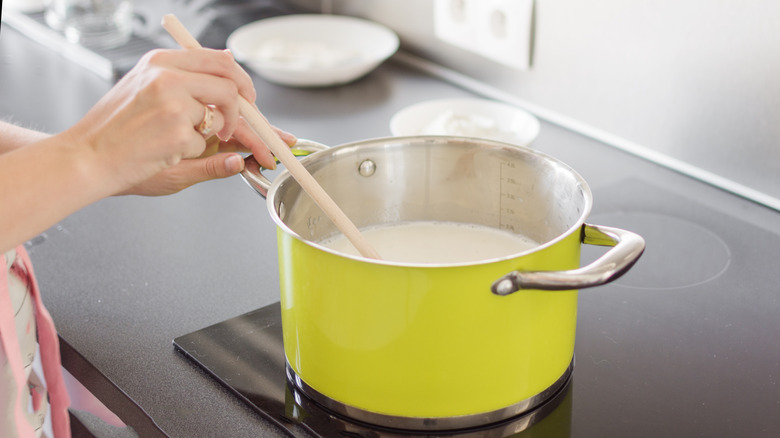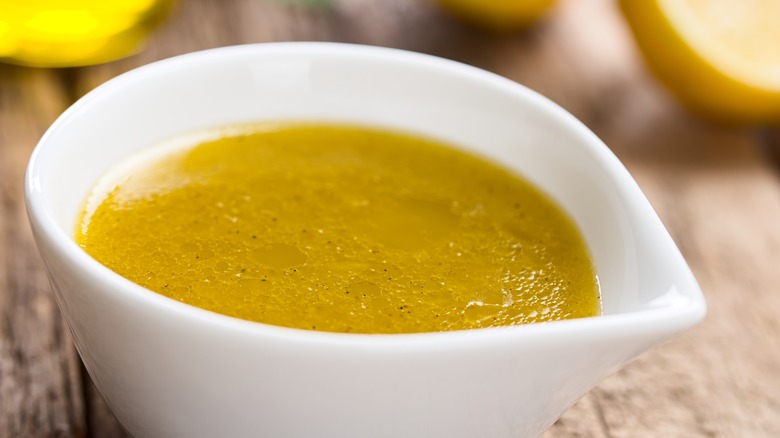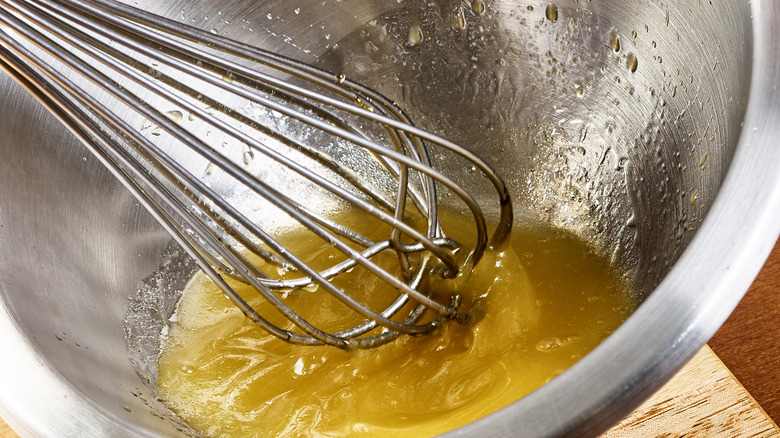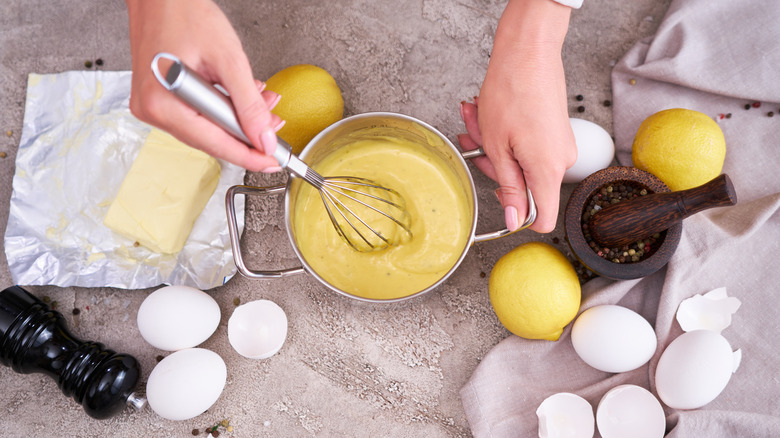How To Make An Emulsified Sauce And Why You Should Care
Think about your favorite sauces of all time. What are they? Probably emulsions. To say that a sauce is an emulsion means that it is comprised of two immiscible liquids — meaning those that do not mix together easily — bound together and stabilized by an ingredient called an emulsifying agent to prevent separation. The most common example of an emulsified sauce is vinaigrette, where oil and vinegar are combined to create a stable mixture.
Emulsified sauces are delicious because they blend ingredients that would naturally repel each other. Fat and water don't organically mix, but when forced to combine, their textures and flavors complement one another and are enhanced by the emulsifying agent. The creamy, velvety textures of mayonnaise or hollandaise sauce are luscious because of the egg yolk, which holds the emulsion together by surrounding the fat particles and keeping them suspended in the water.
Emulsions can be versatile. A good beurre blanc — a simple emulsion of wine, vinegar, and butter — pairs well with plenty of fish and vegetables. A well-made mayonnaise with a few extra ingredients makes a mean aioli that can be used in sandwiches or alone as a dip. Mastering emulsions opens the heart of sauce-making and allows you to augment any meal with another layer of flavor and complexity. Here are some of the most important things you need to know about emulsions, as well as how to make them properly to enhance your favorite recipes.
What is emulsification?
Emulsification isn't magic, but it looks like it because the change happens right before our eyes. Scientifically speaking, emulsification works by scattering microscopic particles of one liquid into another immiscible liquid — that is, a liquid that will not dissolve into the other. When these two liquids are emulsified, one is locked into suspension with the other. In cooking, it's often oil into water (like with mayonnaise and vinaigrettes), but it can sometimes be water into oil (like with butter and chocolate).
For an emulsion to remain stable and unbroken, an emulsifying agent must also be in the mix. An emulsifying agent is an ingredient that can isolate the individual droplets of the suspended liquid to keep it from breaking the emulsion. Emulsifying agents, like lecithin in egg yolks, can link to both water and fat. When introduced to water and oil, the emulsifying agent becomes a sort of connection between the two immiscible liquids.Without an emulsifying agent, the oil and water rapidly separate. If you've ever made a red wine vinaigrette for a salad using just red wine vinegar and olive oil, you'll notice this is the case. Shaking the bottle keeps the two liquids together long enough to squeeze it out onto the salad, but when you come back to it after dinner, you'll likely notice that the mixture has already separated.
Emulsified sauces taste better
As with most things in cooking, emulsifying a sauce is all about balance — as much for ingredients as for flavor. Depending on the sauce or the mixture, the fat and water ratio must be balanced, or the emulsion will break. But a perfect — and often precarious — balance of oil and water creates the sensation of smoothness and creaminess that is irreplicable in most other sauce-making techniques. Emulsified sauces coat surfaces, making them feel pleasantly thick on the tongue and look aesthetically pleasing when spooned over other ingredients. This thickness is also often desirable in baking, as in the case of an almond emulsion in a vanilla cake.
Beyond their unique texture, emulsified sauces also help express and retain the flavors of the ingredients used in the mixture. Emulsions with higher concentrations of dispersed oil have been shown to better retain flavors of ingredients that are immiscible with water, which suggests that emulsions can be made to help preserve certain flavors. Because certain flavors of each liquid are diluted by the other, their intensity can be made milder and their nuances more perceivable. Take, for example, a red wine vinaigrette made with extra virgin olive oil. The olive oil dilutes the sourness of the vinegar, while the vinegar does the same for the bitterness of the oil. Together, the two balance each others' intense flavors and help express underlying flavor notes.
Emulsifications are important
Many aspects of the culinary arts we've come to know and love would fall flat without emulsions. Some of the best things in cooking, like gravy, owe their delicious flavor and texture to the science of emulsion. Without the protein extracted from the bones used to make stock, classic turkey gravy could never be as velvety and rich. This is because the butter used in the roux and the fat rendered from the bird would separate from the water. Most of Escoffier's mother sauces — hollandaise, velouté, béchamel, and espagnole — wouldn't be possible, either.
Without emulsions, there would be no cream, ice cream, butter, milk, butter, or eggs. Say goodbye to hot dogs and sausages and the ranch or Caesar in your salad, too. Chocolate may have never been invented without emulsifiers, either. In baking, many doughs enriched with fat — like puff pastry, choux, brioche, and Danish pastry — wouldn't exist. A world without emulsions is a world without culinary innovations. Many of the foods we know, love, and take for granted would be but a figment of our collective imagination.
Naturally-occurring emulsifications
Though fat and water don't mix naturally, there are some emulsions of fat and water that occur without human tinkering. Fresh, unadulterated milk from animals is an emulsion of butterfat and a watery liquid containing nutrients like protein and minerals. When left standing, the emulsion of raw milk will break, and a cream layer will rise to the top, leaving the lower-fat liquid at the bottom. The homogenization process breaks down the butterfat in milk into a smaller size, effectively whipping it into a more permanent emulsion. This applies to the milk most people purchase in the grocery store, which has a creamy, smooth texture. The proteins (whey and casein) and phospholipids in milk act as emulsifiers and keep milk in a stable, homogenous state.
Egg yolks, too, are natural emulsions. They contain water, proteins, fats, and other compounds held in emulsion by the natural phospholipid lecithin. These qualities make eggs a popular ingredient in many other emulsions, including as a stabilizing agent in mayonnaise and hollandaise, as well as in many custards and baby foods.
Classic emulsified sauces
Some of the oldest sauces we know are made via emulsification, with the two most pertinent examples being mayonnaise and hollandaise. Classic mayonnaise is an emulsion made by mixing white wine vinegar or lemon juice (or both), mustard, salt, and sugar with oil. Hollandaise sauce is a similar emulsion, but in its most rudimentary form, uses only egg yolks, clarified butter, and lemon juice or vinegar. The egg yolks in hollandaise sauce are also cooked slightly over steam, which contributes to the sauce's thick texture.
Mayonnaise and hollandaise are the foundation of many more derivative sauces that add ingredients, complexity, and versatility to the base sauces. Remoulade sauce, for example, is a mayo-based French sauce that has grown roots in Louisiana Creole and Cajun cuisine. It pairs beautifully with fried green tomatoes and seafood. It's made with plenty of spices, like paprika and cayenne, as well as capers, hot sauce, and Worcestershire. Bearnaise sauce is the same emulsified hollandaise, with the addition of champagne vinegar, shallots, and lots of tarragon. It's popular on steaks and veggies alike.
Start by gathering your mise en place
To make a good emulsified sauce — and to cook anything, really — the best place to start is by gathering your mise en place. Mise en place is a French cooking term used in professional and home kitchens alike. It translates to "putting in place," but the term refers to gathering everything you need to cook, like your ingredients, tools, and cookware. To do this, it helps to read your recipe thoroughly first before starting any prep and then make a list. If you are making mayonnaise, for example, you will need eggs, mustard, lemons, salt, sugar, and oil. You'll also need a large bowl and whisk, a powerful blender, or a food processor.
Before you start cooking, make sure that your ingredients are correctly prepped and set out in front of you. After all, you don't want to be in the middle of whisking in a drizzle of oil when you suddenly remember that you still need lemon juice. Make sure your lemon is squeezed, your yolks are separated from the whites, and your space is tidy and ready for work.
Prepare ingredients, agitate, and add oil
Before you start making the emulsion, it's important to keep the oil and water-based ingredients separate from one another. Following your desired recipe closely, measure out the amount of oil and water-based ingredients you'll need. To make things more efficient, you can combine the emulsifying agents with the water-based ingredients ahead of time. In your mayonnaise, for example, this will be the vinegar or lemon juice, egg yolks, and mustard. These ingredients are going to go in your working container — the bowl, blender, or food processor — first. Only once they are fully combined will you begin adding your oil.
This next step is the one that takes finesse. While whisking, blending, or processing, drizzle your oil slowly and in a steady stream. When making mayonnaise in a mixing bowl, whisk the egg yolks, mustard, and vinegar vigorously in steady circles while, with the other hand drizzling the oil into the center of the circles you're making. Be sure to whisk up the oil that falls into the mixture. This process is made much easier and less arduous with a food processor, blender, stand mixer, or immersion blender. If it looks like not all the oil is being incorporated right away, you might need to ease up on your stream and pour slower. Adding oil in small increments will help bring it into suspension more readily without overwhelming the liquids and emulsifying agents.
Taste and adjust
No sauce is complete without making sure everything is flavorful and balanced. The easiest way to do this is to taste it. Your mayonnaise may look light and fluffy — with a custardy yellowish-white hue. Now, taste it. If it's coming up bland, you can add salt. Or, correct a flat-tasting sauce with some lemon juice, vinegar, or mustard. To curb the acid, you might consider reaching for oil or sugar.
But what if your mayonnaise doesn't look light and fluffy in the first place? If you've got a loose or watery-looking mayonnaise, it means you probably didn't add enough fat. Start whisking again and drizzle in more oil until the mixture thickens to the desired consistency. Remember that recipes often can't account for variations in the type of oil you use, the size or makeup of your specific egg yolks, or the kind of salt you're seasoning with. It's ultimately up to you to decide what tastes and looks right.
Hold it steady
Once your emulsion is mixed and seasoned, you'll want to ensure it goes in the proper storage container for ease of use and safe keeping. First, think about the components of the sauce you made. If you've made mayonnaise, remember that the sauce contains raw eggs and will spoil if exposed to air for too long. You can easily make your vinaigrette in a squeeze bottle, as it allows you to shake up the mixture to re-emulsify any separated parts and squirt it right over your salad. If you want to squirt some neat lines of mayo on a sandwich or over some fries, a squeeze bottle might also be your best bet. Otherwise, a jar with a wide-mouth lid is perfect for scooping and spreading over bread or into a mixing bowl to make an aioli or remoulade.
The temperature at which your sauce needs to be held will also affect the container you choose. Hollandaise can't be saved and reheated, so it needs to be kept at a consistently warm temperature. That means you'll need to keep the sauce in something that can withstand heat. For that reason, a bain marie, thermos, or thermally-insulated coffee carafe are all usually good options.
Why temperature matters
Although your emulsion is done, your work isn't quite over yet. Holding an emulsion at a specific temperature is crucial for the stability and quality of the sauce. You should never let some emulsions like hollandaise sauce get cold because the sauce will break. The temperature of the fat you add to the emulsion also matters just as much. When making a beurre blanc, the butter you whisk in should be cold chunks so that it falls into the mixture little by little as it melts. Similarly, if the butter you use for your hollandaise gets too hot, it could separate, or worse, it could scramble the egg yolks in your emulsion.
Because sauces like hollandaise need to be held at a very particular temperature throughout their use, there is always the question of food safety in mind. Anthony Bourdain famously cautioned restaurant hollandaise sauce in his memoir, "Kitchen Confidential," calling it "a veritable petri dish of biohazards." Bourdain is referring to the fact that hollandaise, which is fussy enough to need to be held at or around 120 F or so, sits far below a food-safe temperature for the entirety of a brunch service (several hours). A well-covered and constantly-maintained vat of hollandaise still could be a potential food-safety risk, so consume at your own discretion.
What is a broken emulsion?
An emulsion breaks when the suspended liquid molecules fall out of their homogenous mixture and separate back into their original states. The reasons for an emulsion breaking are numerous but could be a result of an imbalance in liquid ratios, using an insufficient amount of emulsifying agent, bad technique, changes in temperature, or over-mixing. Emulsions are often fickle by nature, and sometimes, one small mistake can topple the precarious balance in one direction or another.
Sometimes, all it takes is a little too much water or oil to break things apart, but fortunately, many emulsions can be fixed with a bit of finesse. Breaking an emulsion is never fun (except in the case of making homemade butter from heavy cream), but it's important to understand why your emulsion broke so you can learn what went wrong, how to fix it (if possible), and what to do or avoid in the future.
How to fix a broken mayonnaise
Mayonnaise is typically one of those sturdy emulsions known for its impenetrable thickness, but breaking can happen. If your mayo is splitting, it's likely because you either have too much oil in the equation, didn't mix hard enough, added too much oil at once, or didn't use enough egg yolk or mustard.
To fix it, start in a separate container with a small amount of one of the emulsifying agents, mustard or egg yolk, and lemon juice. Slowly add a small amount of the broken mayonnaise to an equally small amount of the emulsifying agent, and begin vigorously beating or agitating the mixture until it's creamy and reincorporated. Continue adding the rest of the broken mayonnaise, little by little, until the entire mixture comes back together. If you notice it starts to split again at the surface, try adding a small amount of water, lemon juice, or vinegar to tip it back into balance.
How to fix a broken hollandaise
Hollandaise is a much more fickle beast than mayo. Not only can it be a pain to make, but it's also a difficult one to fix. First, check your hollandaise to see exactly how it broke. If you see curds in the sauce, there's nothing more you can do. Curdling is an indicator that you have overcooked your egg yolks. At that point, you have to throw the hollandaise out and start again.
However, if your sauce is splitting, meaning that the oil and water are separating, don't worry — it can be saved. One solid trick to rescue broken hollandaise sauce is to bring it back into emulsion by adding a little water. Bring some water to a boil and, using very small measurements (we're talking tablespoons), whisk in a little bit of hot water at a time to bring the sauce back together. Make sure the water you're adding isn't too hot, or you risk curdling your hollandaise.
